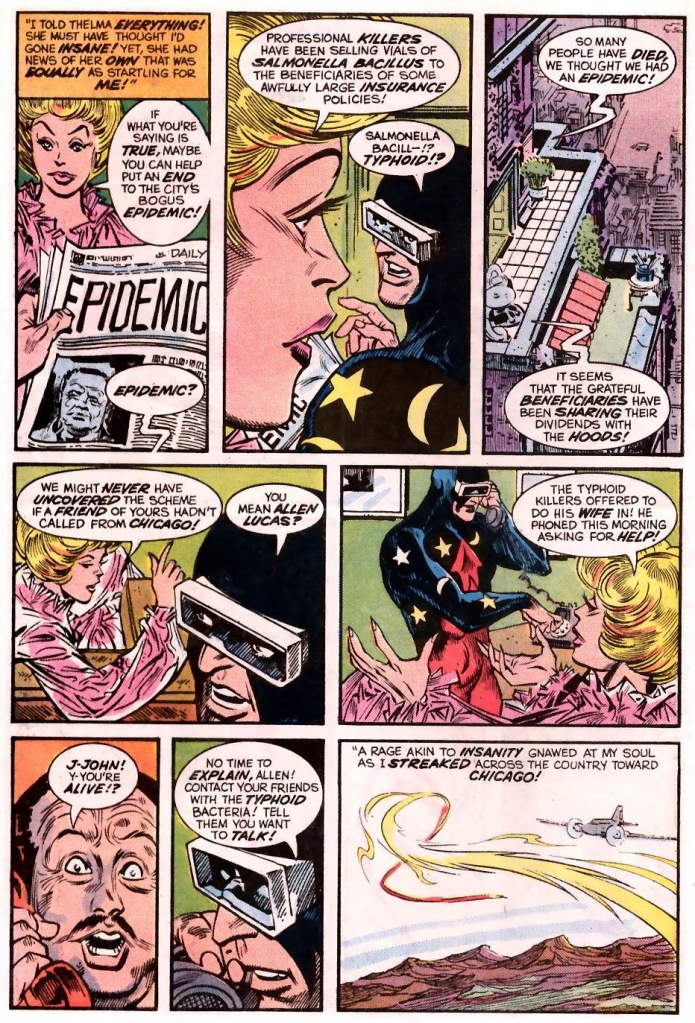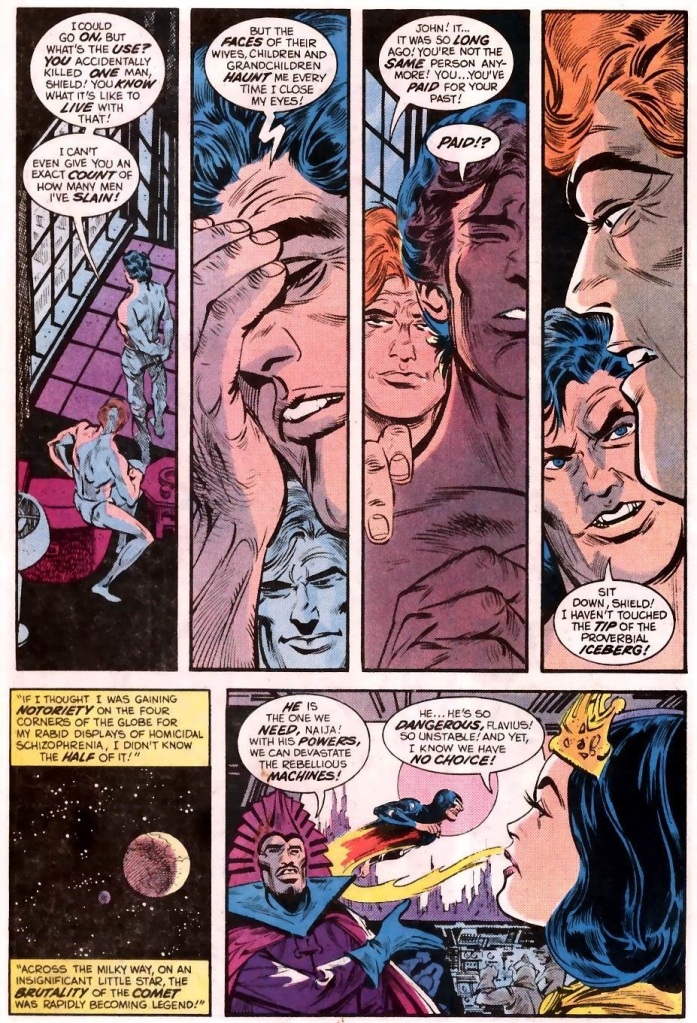
Archie Comics’ attempt to get back into the super hero marketplace in 1983 under their Red Circle imprint was, by all accounts, a bit of a mess. It was an experiment that played itself out over around two years, and which produced some interesting experiments as well as a bunch of just out-and-out junk. The biggest underlying difficulty was that the management at Archie wasn’t committed to the idea of doing super heroes and trying to create a beachhead in the newly-developing Direct Sales Market. They were devoted to their bread-and-butter teen humor titles, and so as time went on, budgets were slashed, editorial and creative teams were completely changed on the fly, and any vision the line may have had at any point was plowed under. it was an ignominious operation.

In another part, the folks behind Red Circle couldn’t ever entirely land on what they were publishing and who their target audience was. Their releases ran the gamut in terms of being typical super hero titles aimed at the younger set of readers all the way up to books that pushed the confines of the Comics Code (or even stepped outside of it) in an attempt to craft more adult fare. THE COMET was definitely an attempt at the latter, though its execution wasn’t quite up to the aspirations of its creators.

The comet had been created by cartoonist Jack Cole back in the 1940s, and initially reflected Cole’s sensibilities and sense of humor. Which is to say, he was an especially violent super hero for the age, who routinely disintegrated his foes with beams from his eyes. The Comet wasn’t especially popular, and his audience waned after Cole moved on following the fourth installment of his series in PEP COMICS. But the character was memorable in another way: he was virtually the first super hero to be killed off. We covered the Death of the Comet in the piece below.

The comet’s death was used as the inciting incident to transform his heretofore-unrevealed brother into a more grounded though no less brutal crimefighter known as the Hangman. The hangman was more successful than the Comet, and his series ran pretty much up to the point where Archie decided to end their hero material in favor of teen hijinks exclusively.

In the 1960s, though, as the broadcast of the Batman television show propelled interest in costumed crime-busters through the roof, Archie decided to bring back a bunch of their 1940s super-stars in order to cash in on this wave of interest. Among those who was revived was the Comet, though he was almost an entirely different character apart from the name. He had different powers, a different look and a different background. An attempt was made to reconcile these differences and connect him to Jack Cole’s character from the 1940s, but it was relatively surface stuff, and treated pretty casually in the manner of the camp approach taken to the entire Mighty Comics series of releases.

With the rise of fandom, though, came a whole bunch of creators who loved to attempt to untangle the continuity of the past, and to use it in the service of creating new stories in the present. Roy Thomas is likely the poster child for this approach to storytelling, but there were plenty of others along the way. So it was that Bill Dubay decided not only to revive the Comet in a six-issue limited series, but that it would be Direct Market exclusive and thus not bound by the Comics Code. he also determined to use it to streamline and make plausible all of the irregularities in the Comet’s past history (this despite the fact that the most recent of these stories was almost twenty years old when he undertook the assignment) and use them to try to craft a more adult story about abuse and upbringing.

Dubay’s ambitions here may have outstripped his abilities, but he gave his endeavor a game shot. On the art front, he brought Carmine Infantino on board. Having been ousted from his position as DC’s Publisher at teh start of 1976, Carmine had gone back to the drawing board, working on a bevy of stories for Warren Publishing where Dubay cut his teeth. Infantno’s style had fallen out of favor somewhat in the marketplace, his once-slick and expansive work now more angular and labored. But he was a living legend with some real credentials to point to when it came to reviving stale old super hero properties.

In order to slicken up and modernize Infantino’s work somewhat, Dubay paired him with inker Alex Nino. A talented artist in his own right, Nino was part of a group of artists brought into the American filed by Infantino and DC editor Joe Orlando from the Philippines in the early 1970s. The reason said artists were so welcome was that the dollar was immensely strong in the Philippines at the time, meaning that DC and other companies could pay these artists less than the standard American rates and they would still be happy and produce mountains of work. Nino wasn’t especially skilled at doing super hero strips, but he was amazing at adding texture and flavor to a page.

Ultimately, the disarray at Archie meant that only two issues of THE COMET were published before the magazine was discontinued, its story never concluded. But even unfinished and flawed, it remains one of the better things that Red Circle did during its years of operation. And it also presaged the type of brutal vigilante anti-hero that would become a dominant sub-genre in the field in just a couple of years’ time.












I iwhs I could have back all the time I spent looking for issue #3!
LikeLiked by 1 person
I remember buying the entire line ( after the fact ) from Chuck at Mile High for about 50 cents an issue.
I liked Blue Ribbon, and the Fly. But I felt they were, at best, only worth 25 cents an issue. (I grew up paying 12 cents for a comic.) Altho I thought they were junk when I was a kid, I admit I get quite a kick out of Archie’s 1960s superheroes now. They are so inept they are brilliantly funny. Same goes with the robot Captain Marvel (Split!). I collect comics mainly for the art, so the goofiness of the writing doesn’t matter to me. Thanks for bring these up…now I want to dig ’em out and have fun with them again.
.
LikeLiked by 1 person
My goodness, that story really does do a remarkable job trying to pull all the past histories of the Comet together.
LikeLike
A clarification re Infantino: IIRC, his first work after DC was a bunch of work for Warren, as Tom noted. After that, though, he did a stint at Marvel. There, he drew the first Jessica Drew Spiderwoman, issues of Nova (some inked by Tom Palmer — gorgeous) and a longish run on Star Wars.
LikeLiked by 2 people
I really liked Terry Austin’s finishes over Infantino on the Star Wars comic book. That was also gorgeous stuff.
LikeLike
Alex Nino’s finishes over Carmine Infantino’s layouts resulted in some really gorgeous artwork.
Looking at these two issues, I agree that Bill Dubay’s ambitions perhaps exceed his ability, but I can admire him for attempting to stretch the boundaries of the superhero genre somewhat. So, it’s a bit of a pity that the full miniseries never came out. At least the second issue of the Comet ended with a certain amount of closure, so fortunately readers were not left for all time wondering how a cliffhanger might have resolved itself. I’ve always hated when that happens on cancelled titles.
LikeLike